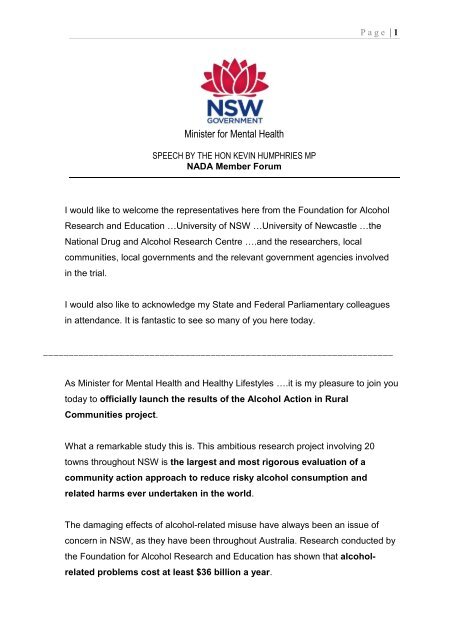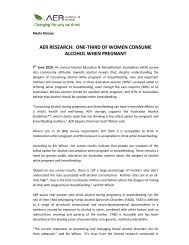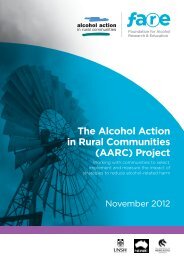The Hon Kevin Humphries MP, NSW Minister for Mental Health - FARE
The Hon Kevin Humphries MP, NSW Minister for Mental Health - FARE
The Hon Kevin Humphries MP, NSW Minister for Mental Health - FARE
Create successful ePaper yourself
Turn your PDF publications into a flip-book with our unique Google optimized e-Paper software.
P a g e | 1<br />
<strong>Minister</strong> <strong>for</strong> <strong>Mental</strong> <strong>Health</strong><br />
SPEECH BY THE HON KEVIN HU<strong>MP</strong>HRIES <strong>MP</strong><br />
NADA Member Forum<br />
I would like to welcome the representatives here from the Foundation <strong>for</strong> Alcohol<br />
Research and Education …University of <strong>NSW</strong> …University of Newcastle …the<br />
National Drug and Alcohol Research Centre ….and the researchers, local<br />
communities, local governments and the relevant government agencies involved<br />
in the trial.<br />
I would also like to acknowledge my State and Federal Parliamentary colleagues<br />
in attendance. It is fantastic to see so many of you here today.<br />
_____________________________________________________________________<br />
As <strong>Minister</strong> <strong>for</strong> <strong>Mental</strong> <strong>Health</strong> and <strong>Health</strong>y Lifestyles ….it is my pleasure to join you<br />
today to officially launch the results of the Alcohol Action in Rural<br />
Communities project.<br />
What a remarkable study this is. This ambitious research project involving 20<br />
towns throughout <strong>NSW</strong> is the largest and most rigorous evaluation of a<br />
community action approach to reduce risky alcohol consumption and<br />
related harms ever undertaken in the world.<br />
<strong>The</strong> damaging effects of alcohol-related misuse have always been an issue of<br />
concern in <strong>NSW</strong>, as they have been throughout Australia. Research conducted by<br />
the Foundation <strong>for</strong> Alcohol Research and Education has shown that alcoholrelated<br />
problems cost at least $36 billion a year.
P a g e | 2<br />
We know that Australia has some of the highest rates of risky drinking in the world.<br />
Some alarming statistics relating to risk drinking were reported in the 2010<br />
National Drug Strategy Household Survey, which found that:<br />
<br />
one in five people drink alcohol at a level that puts them at risk of harm or<br />
injury over their lifetime – one of the highest rates in the world;<br />
<br />
at least once a week, about one in six people put themselves at risk of an<br />
alcohol-related injury from a single occasion of drinking;<br />
<br />
at least once a month, about two thirds of 18-19 year old males, and more<br />
than half of 20-29 year old males, put themselves at risk of alcohol related<br />
injury.<br />
In Australia, drinking too much on a single occasion …binge drinking …is by far<br />
the most common type of excessive drinking, and the consequences are all too<br />
visible on Friday and Saturday nights in communities throughout <strong>NSW</strong>. <strong>The</strong>y<br />
range from the serious – the street brawls, the hospital ED admissions, the<br />
assaults …to the threatening – the verbal abuse and intimidating behaviour of<br />
intoxicated individuals and groups.<br />
<strong>The</strong> <strong>NSW</strong> Government is well aware of the harmful effects of alcohol misuse and<br />
is committed to taking action that will reduce these effects, with one of the goals of<br />
the 2012 <strong>NSW</strong> Plan to reduce total risk drinking by 25 per cent across the State by<br />
2015. But there are two caveats here: firstly, good solutions cannot be<br />
devised independently of communities – whether the solutions are legislative<br />
or local-action, community support is a vital ingredient. Secondly, the solutions<br />
must be in<strong>for</strong>med by evidence …put simply, solutions need to demonstrate that<br />
they provide bang <strong>for</strong> the buck.<br />
Those caveats are why I am so pleased to launch the results of the Alcohol Action<br />
in Rural Communities project here today. This world leading researchclearly<br />
shows that communities can work effectively with their local government,<br />
health services, police, schools and a range of key stakeholders to devise
P a g e | 3<br />
and implement their own community-based solutions.<br />
But just as importantly, local communities had the opportunity to engage with<br />
researchers who have skills in real world evaluation of policies and programs, to<br />
ensure their solutions were consistent with existing evidence …and to ensure their<br />
solutions were subjected to rigorous evaluation.<br />
I would just like to emphasise this point because it is crucial to understanding the<br />
importance of this research. As Associate Professor Anthony Shakeshaft will<br />
discuss in a moment, the evaluation design was a randomised controlled trial,<br />
which is the most rigorous design there is.<br />
This process of randomising whole communities to evaluate alcohol interventions<br />
has only ever been done once be<strong>for</strong>e in the US ….and only to assess the impact<br />
on drinking and harms among young people. So this project is the first<br />
internationally to measure the impacts across the whole community. It is a<br />
remarkable achievement.<br />
So what did the communities actually do, and did it work I’ll leave the details to<br />
Anthony, but a number of interventions were systematically implemented over a<br />
five-year period in each of 10 communities in regional <strong>NSW</strong>. And it was a range of<br />
different interventions applied together which made a real difference - providing<br />
communities with in<strong>for</strong>mation about drinking patterns and harms that are specific<br />
to them, including targeting their own high-risk weekends was an important place<br />
to start.<br />
Working with schools, with hospitals, with GPs, with pubs and clubs, and with local<br />
government together was critical to ensure that alcohol was seen as a communitywide<br />
issue, not just a problem <strong>for</strong> the local GPs or police to deal with.<br />
<strong>The</strong> main results <strong>for</strong> the 10 active communities, compared to the 10 nonactive<br />
or control communities, were a:<br />
20 per cent reduction n in average alcohol consumption;
P a g e | 4<br />
<br />
42 per cent reduction in residents’ experience of alcohol fuelled verbal<br />
abuse;<br />
<br />
33 per cent reduction in alcohol-related street offences;<br />
<br />
30 per cent reduction in the number of residents who reported drinking at<br />
levels that placed them at high-risk of alcohol-related violence, accidents<br />
and injuries .<br />
Given the known relationships between excessive alcohol consumption and poor<br />
physical and mental health, these findings are particularly encouraging.<br />
<strong>The</strong> Alcohol Action in Rural Communities project has shown that collaboration<br />
between communities and researchers is not only possible, but can achieve<br />
internationally recognised results. <strong>The</strong>re is a good opportunity now to think about<br />
how we can get better at this sort of collaboration in across our communities in<br />
<strong>NSW</strong>, and develop responses which have proven to work in our communities, and<br />
which communities will have responsibility <strong>for</strong>.<br />
From the Government’s perspective, we will continue to engage with the<br />
community to reduce the harmful effects of alcohol through programs such as the<br />
Community Drug Action Teams, which enable local communities to identify and<br />
reduce the harm caused by the misuse of alcohol and other drugs within their<br />
communities.<br />
<strong>The</strong>re are currently over 80 CDATs across <strong>NSW</strong> that undertake various projects in<br />
response to alcohol misuse including poster campaigns, in<strong>for</strong>mation days, youth<br />
<strong>for</strong>ums, music festivals and mentoring programs.<br />
Since the AARC project and CDATS share the same aim, the results of the<br />
AARC study are expected to have a significant impact on the work undertaken by<br />
CDATs through its assessment and measurement of the most effective types of<br />
intervention to reduce alcohol related harm in local communities.
P a g e | 5<br />
In addition to this, the <strong>NSW</strong> Government recently launched the What are you<br />
doing to yourself responsible drinking campaign, which aims to reduce<br />
excessive drinking and public drunkenness in the Kings Cross area through the<br />
promotion of personal responsibility to the consumption of alcohol.<br />
<strong>The</strong> campaign places the responsibility of responsible drinking on the individual,<br />
with a focus on how much they consume and the consequences. It is a great<br />
example of a targeted, localised campaign in action.<br />
I commend everybody involved in the world leading AARC trial.






